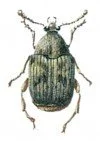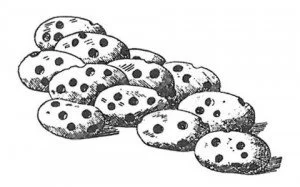

Latin: Acantoscelides obtectus.
This is a 2 – 4 mm long, oval beetle, which is brown on the top side with yellowish green hair and light gray stripes. The common bean weevil is a tropical species based in South America. It comes to Europe with imported goods and since it can complete its development at temperatures as low as 16-17 ° C, it can be very harmful in the summer months and in heated storages. At optimal temperatures which are 27 – 31 ° C the weevils increase their number 25 times in just one month.
The female common bean weevil lays up to 85 white, oblong eggs between beans or peas. The larvae that hatch are white and have three pairs of relatively long legs. The larvae eat their way immediately into seeds. The next three larval stages, which live inside seeds, are plump and legless. In the end of the fourth larvae stage they pupate just below the surface of seeds. There may well be cramped.

Up to 28 larvae have been found in a single bean. As the common bean weevil is a member of the Bruchidae family, it is also subject to the import restrictions that apply to this entire family, see above. Common bean weevils are exterminated in the same manner as granary weevils.




